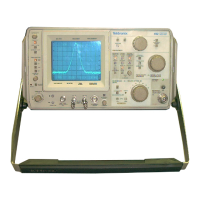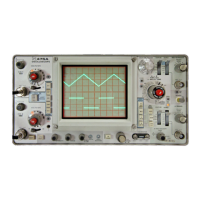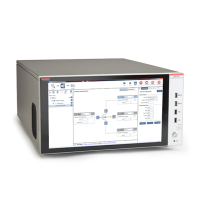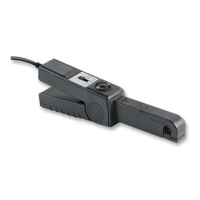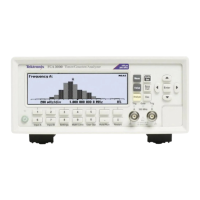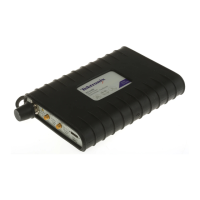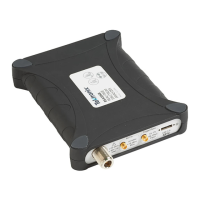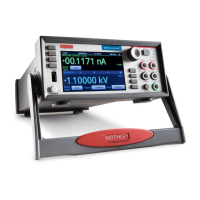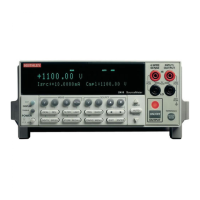TABLE 5-4a
LIN;
≥26δΒ.
LOG; ≥40 dB.
SQ LAW;
≥13δΒ
b. Apply 200 MHz signal that has an amplitude less than
-40 dBm, from a VHF Signal Generator that has a cali-
brated variable output attenuator, to band B RF INPUT con-
nector.
c. Adjust the GAIN control and the variable attenuator
of the Signal Generator for a display amplitude of 8 divi-
sions (full screen).
d. Increase the output attenuation of the VHF Signal Gen-
erator until the signal is just visible (about 0.5 minor divi-
sion) on the display. Note the difference in the attenuator
readings.
e. Check the dynamic range of each VERTICAL DISPLAY
switch position. Must equal or exceed the range listed in
step a.
f. Return the VERTICAL DISPLAY switch to the LIN posi-
tion.
18. Check Accuracy of IF ATTENUATOR
dB Selectors
Accuracy of the IF ATTENUATOR dB selectors is checked
at the factory to insure that they are within 0.1 dB/dB specifi-
cation. Any change in this tolerance should be a large one and
due to component failure. Step attenuators with rigid
specifications are, therefore, not recommended. However, if
the user desires a precise check of the attenuator error, he
must either accurately calibrate the recommended equipment
or use step attenuators with more rigid specification.
a. Requirement-IF ATTENUATOR selections must remain
within 0.1dB/dB.
b. Apply a 200 MHz signal from the signal generator that
is 10 dB below 1 mW, through a 2X attenuator (6 dB), a Tens
and Units step attenuator and a 10X attenuator (20 dB) to the
Type 491 RF INPUT connector. (Fig. 5-5).
c. Set the Tens attenuator far 20 dB attenuation and the
Units attenuator for 12 dB attenuation.
d. Adjust the GAIN control far a signal amplitude of 6
divisions on the analyzer screen.
e. Check the accuracy of the IF ATTENUTOR dB selectors
as follows:
1. Switch the Type 491 1 dB attenuator siwtch to ON and
switch out 1 dB of attenuation through the units step attenua-
tor.
2. Check the display amplitude. Must equal 6 div. ±0.7
minor division (.1 dB/dB).
3. Switch the IF ATTENUATOR switch to OFF position,
then check the remaining IF ATTENUATOR switch steps
as directed in Table 5-4a.
Spectrum Step
Signal Amplitude
Analyer Attenuators
Limits (.1 dB/dB)
Units Tens
1 dB
11
20
5.93 to 6.07 div
2 dB
10 20
5.86 to 6.14 div
4 dB
8
20 5.6 to 6.3 div
8 dB
-
4
20
5.5 to 6.6 div
16 dB
6
10
5.0 to 7.2 div
20 dB
210
4.7 to 7.6 div
The 1 and 2 dB measurements are very difficult, because
of signal stability and the noise level. For these small signal
levels, the square law mode may be used to expand the
screen changes, for the some level change by the square
power as listed in Table 5-4b.
TABLE 5-4b
An alternate method which is not as accurate but is suf-
ficient for most applications is as follows:
1. Apply a 200 MHz signal (at 60 dB below 1 mW, as
shown an the Attenuator dial) from the signal generatar
to the RF INPUT connector. Adjust the Spectrum Analyzer
GAIN control for a signal amplitude of 5 divisions.
2. Switch the 1 dB IF ATTENUATOR switch on and adjust
the signal generator output attenuator control to return the
signal amplitude to 5 divisions.
3. Check the new reading of the attenuator dial. Should
read -59 dBm.
4. Turn the 1 dB IF ATTENUATOR switch to OFF. Check
the remainder of the IF ATTENUATOR selector steps as
directed in Table 5-4c.
TABLE 5-4c
19. Check Attenuation Range of IF GAIN
Control
a. Requirement-The IF GAIN control range should equal
or exceed 50 dB.
b. Turn the GAIN control fully counterclockwise. Adjust
the VHF Signal Generator output for an 8 division signal
amplitude. Note the variable attenuator dial reading.
c. Increase the output attenuation 50 dB from the noted
position.
5-8

